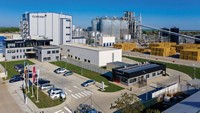Advertisement
Grab your lab coat. Let's get started
Welcome!
Welcome!
Create an account below to get 6 C&EN articles per month, receive newsletters and more - all free.
It seems this is your first time logging in online. Please enter the following information to continue.
As an ACS member you automatically get access to this site. All we need is few more details to create your reading experience.
Not you? Sign in with a different account.
Not you? Sign in with a different account.
ERROR 1
ERROR 1
ERROR 2
ERROR 2
ERROR 2
ERROR 2
ERROR 2
Password and Confirm password must match.
If you have an ACS member number, please enter it here so we can link this account to your membership. (optional)
ERROR 2
ACS values your privacy. By submitting your information, you are gaining access to C&EN and subscribing to our weekly newsletter. We use the information you provide to make your reading experience better, and we will never sell your data to third party members.
Environment
Cellulosic Scale-Up
August 10, 2009
| A version of this story appeared in
Volume 87, Issue 32
Your welcomed article "Cellulosic Scale-Up" was in error when it stated that "there has never been commercial production of cellulosic ethanol" (C&EN, April 27, page 10). Ethanol has been produced from cellulose for almost 100 years. The technology progressed most rapidly around World War II, when shipments of oil across oceans were severely limited and highly risky. Germany, Russia, and the U.S. were leaders in the construction of pilot and production facilities for cellulosic ethanol. The practice continued well into the 1990s in the U.S. when Georgia-Pacific was listed as one of the major contributors to the domestic ethanol market. It continues today in several European and Asian countries.
What is different between the existing cellulosic ethanol schemes and the Energy Department projects described in the article is the method of cellulose-to-glucose conversion. In contrast to cornstarch (also a "polyglucose," like cellulose), cellulose virtually never occurs in pure form, and its depolymerization to glucose is highly complex. In practical terms, this means that cellulosic ethanol in commercially existing and economically viable processes is always a coproduct of the manufacture of pulp for paper products and such cellulose derivatives as cellulose acetate.
It is the lesson of end-product multiplicity that the renewable fuels industry has to learn from paper producers and oil refiners. A 30-cent-per-lb single end product, ethanol, produced in less than 30% yield from an agricultural or forest resource through technologically challenging process technology (based on isolated enzymes) remains an invitation for fiscal disaster.
The solution to cellulosic ethanol must lie in product multiplicity. Glucose from cellulosic resources will continue to be viable only if it draws advantage from its associated natural polymeric constituents, amorphous heteropolysaccharides and polyaromatic lignin. The latter have seen much attention recently, and there have been numerous demonstrations of utility in various chemicals and materials.
A shift is required from the most recent practice of producing cellulosic pulp alongside some coproducts (of which cellulose may be one) to glucose production with a greater emphasis on coproducts. But cellulosic ethanol has been around for a long time and is likely to be around much longer.
Wolfgang G. Glasser
Richmond, Va.




Join the conversation
Contact the reporter
Submit a Letter to the Editor for publication
Engage with us on Twitter